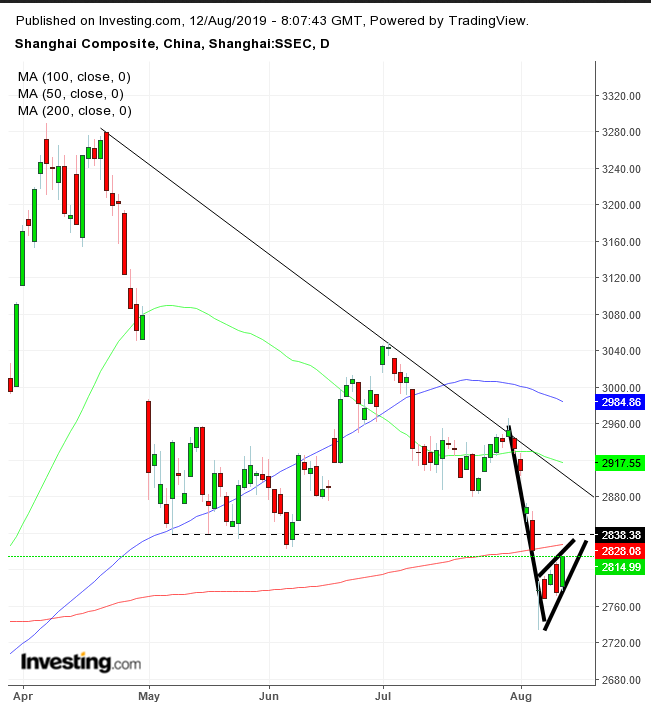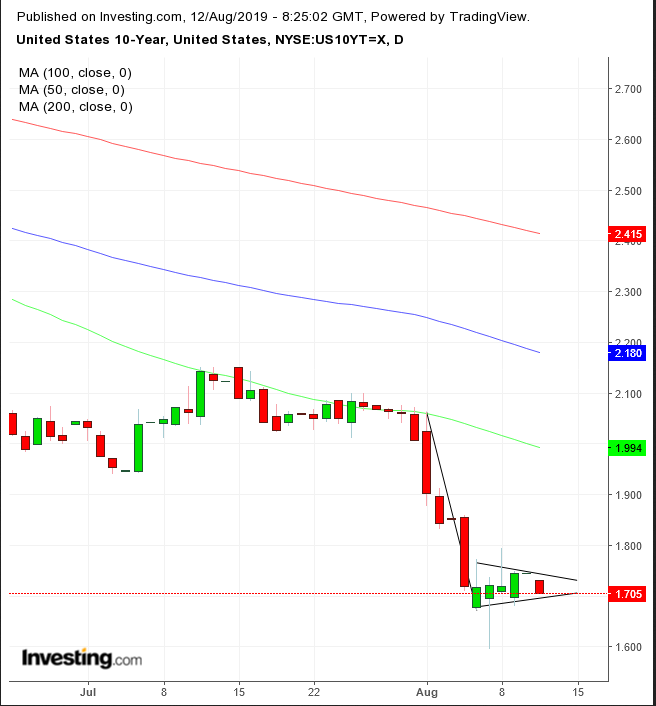- Risk-off shift boosts gold despite rising dollar; Treasurys and Yen reach new highs
Key Events
Futures on the S&P 500, Dow and NASDAQ 100 took a steep turn lower after an upbeat opening this morning, as warnings from China of a potential military response to mounting civil protests in Hong Kong hit investor sentiment.
Before the downward reversal, at the European open, contracts on the SPX were trading at the height of the session, retesting Friday’s highs, while the STOXX 600 was extending an advance, bouncing off the June lows guarded by the 200 DMA and climbing back above the 200 WMA, after a two-week selloff that almost completed a double top.
In the earlier Asian session, Japan and other markets were closed for a holiday. China’s Shanghai Composite jumped 1.45%, with consumer and financial shares taking the lead after the country eased lending rules to offset trade war headwinds. The move drove the region into a rebound, as U.S.-China acrimonious trade headlines took a breather, allowing opportunists to take advantage of valuations that have dropped sharply in the past month: average forward twelve-month price-to-earnings ratios (PE) hovered around 11.1 times as of the end of last week, versus 12.7 times a month ago.

From a technical perspective, however, it appears that the market is not fully prepared to buy into valuations that risk taking another turn lower. The mainland Chinese index formed a rising flag as it crossed below the 200 DMA, after registering a lower trough, extending the downturn.
Hong Kong’s Hang Seng (-0.44%) was the only major regional benchmark to close in the red as civil unrest and security countermeasures in the city continued to escalate.
Global Financial Affairs

Meanwhile, the yields on 10-year Treasurys dropped to the bottom of a pennant-shaped consolidation since Tuesday. After last week’s plunge from above the key 2.00 rate to the lowest level since Oct. 2016, the current range is a set up for a continuation pattern, completed upon a downside breakout below 1.7%. Such a scenario would further weigh on stocks, with the twofold pressure of falling yields and a deepening yield inversion.
In commodities, gold gained ground, holding up against a strengthening dollar.
Oil pared Friday’s gains but traded above the neckline of a down-sloping H&S pattern.
The Japanese yen strengthened despite the rising greenback—pushing the USD/JPY pair to the lowest level since March 2018.
Up Ahead
- Companies releasing results include Barrick Gold (NYSE:GOLD), China’s Tencent (HK:0700), Jd.Com (NASDAQ:JD) and Alibaba (NYSE:BABA), Cisco (NASDAQ:CSCO), Brazilian utility Eletrobras (SA:ELET3), the U.K.’s Prudential (LON:PRU), Australia’s Telstra (ASX:TLS), giant retailer Walmart (NYSE:WMT), NVIDIA (NASDAQ:NVDA), Swisscom (SIX:SCMN) and the Danish brewer Carlsberg (CSE:CARLb).
- The U.S. consumer price index, out on Tuesday, is expected to have ticked up to a 1.7% annual pace in July. Core prices, which exclude food and energy, are seen rising 2.1%.
- Fresh data on Chinese retail sales are due for Wednesday, alongside industrial production and the jobless rate.
- Thursday sees the release of U.S. jobless claims, industrial production and retail sales data.
Market Moves
Stocks
- The MSCI Asia Pacific Index climbed 0.1%.
- The Shanghai Composite increased 1.5%.
Currencies
- The Dollar Index increased 0.23%.
- The euro slid 0.1% to $1.1192.
- The Japanese yen strengthened 0.2% to 105.46 per dollar.
Bonds
- The yield on 10-year Treasurys dropped two basis points to 1.72%.
- Britain’s 10-year yield increased two basis points to 0.504%.
- The spread of Italy’s 10-year bonds over Germany’s fell seven basis points to 2.313 percentage points.
- Germany’s 10-year yield slid less than one basis point to -0.58%.
Commodities
- Gold fell 0.3% to $1,492.34 an ounce, heading for the biggest drop in more than a week.
- West Texas Intermediate crude slipped 0.2% to $54.37 a barrel.
- LME aluminum gained 1%.
- Iron ore fell 1.6% to $87.65 per metric ton.
